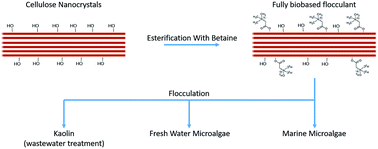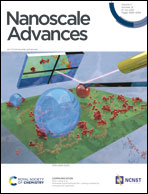Glycine betaine grafted nanocellulose as an effective and bio-based cationic nanocellulose flocculant for wastewater treatment and microalgal harvesting†
Abstract
Flocculation is a widely used technology in industry including for wastewater treatment and microalgae harvesting. To increase the sustainability of wastewater treatment, and to avoid contamination of the harvested microalgal biomass, there is a need for bio-based flocculants to replace synthetic polymer flocculants or metal salt coagulants. We developed the first cellulose nanocrystalline flocculant with a grafted cationic point charge, i.e. glycine betaine (i.e. N,N,N-trimethylglycine) grafted cellulose nanocrystals (CNCs) effective for the flocculation of kaolin (a model system for wastewater treatment), the freshwater microalgae Chlorella vulgaris, and the marine microalgae Nannochloropsis oculata. We successfully grafted glycine betaine onto CNCs using a one-pot reaction using a tosyl chloride activated esterification reaction with a degree of substitution ranging from 0.078 ± 0.003 to 0.152 ± 0.002. The degree of substitution is controlled by the reaction conditions. Flocculation of kaolin (0.5 g L−1) required a dose of 2 mg L−1, a comparable dose to commercial polyacrylamide-based flocculants. Flocculation was also successful for freshwater as well as marine microalgae (biomass concentration about 300 mg L−1 dry matter), although the flocculation efficiency of the latter remained below 80%. The dose to induce flocculation (DS = 0.152 ± 0.002) was 20 mg L−1 for the freshwater Chlorella vulgaris and 46 mg L−1 for the marine Nannochloropsis oculata, comparable to other bio-based flocculants such as chitosan or TanFloc.



 Please wait while we load your content...
Please wait while we load your content...